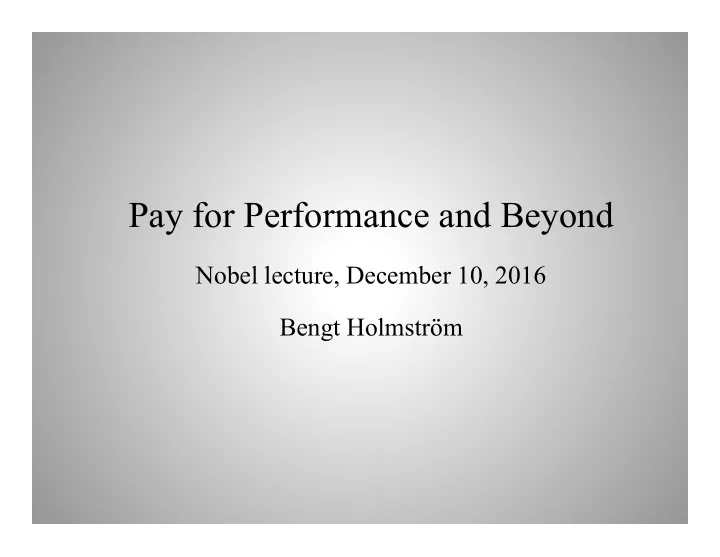

Pay for Performance and Beyond Nobel lecture, December 10, 2016 Bengt Holmström
The Principal ‐ Agent Problem • Employer ‐ Employee, Client ‐ Lawyer, Board ‐ CEO, etc. • Two difficulties – Preferences not aligned – Performance imperfectly measured • Incentive – Contracted pay based on measured outcome
First best and second best Total surplus: P’s Benefit – A’s Cost – Risk cost First best cases: – agent’s choice verifiable => fixed wage – agent risk neutral => rental agreement Second best: – balance incentives against risk
Informativeness Principle • What information is valuable for incentive contracting? – Anything that is informative about the agent’s choice of action (Holmstrom 79, Shavell 79) – Information that is not informative should be excluded • Old accounting principle: pay should only depend on variables that the agent can control • Relative Performance Evaluation and Controllability
Lessons from informativeness Pros: – Reveals exactly how model “thinks” – Explains puzzles about basic P ‐ A model Cons: – Incentive contract oversensitive to information – Model of limited use for predicting optimal shape of incentive contract (Grossman ‐ Hart 83)
Why are contracts linear? (H ‐ M 87) Mirrlees’ example: punishing very rare failures very severely approximates first ‐ best Dymamic version: invites gaming Linear scheme (commission) optimal because it provides constant incentive pressure and avoids gaming (robust)
Linear model with one task Stronger incentive (higher commission) when • Performance measure more precise (less risk) • Agent less risk averse • Value of agent’s effort higher • Agent’s responsiveness to incentive higher First three “obvious” – last one the key
Multitasking (H ‐ M 91, Baker 92) • Many tasks changes the game • Challenging when easy to measure and hard to measure tasks compete for agent’s attention – Quantity versus quality • Related cases – Measures are misaligned with objective – Measures can be easily manipulated
Scandals: “you get what you pay for” • Wells Fargo – fake performance • BP and oil Gulf spill – excessive output incentives at the expense of safety • Enron – conflicting incentives between main firm and subsidiaries • Teachers –teaching to the test
Lessons from multitasking • Two ways to provide incentives for task – Pay more for that task – Pay less for competing (substitute) tasks • Low powered incentives – Low or no incentive may be best incentive when an important task hard to measure – Highly controllable task may not be incentivized
Alternative incentives within firm • Job design – Define tasks (Google – 20% freedom) – Split up easy ‐ to ‐ measure tasks and hard ‐ to ‐ measure tasks • Bureaucratic rules and constraints – Work in the office rather than at home – Can’t work for other companies • Authority, career paths, supervision, recruiting, accounting… Key driver: Employee’s want to be appreciated
Employment vs Contracting Few constraints High High-powered incentives Strong output monitoring Freedom Many constraints Low-powered incentives Strong input Low monitoring Low High Incentive Power
Two roles of firm boundaries • External role (Grossman ‐ Hart ‐ Moore) – Assets strategic chips in market • Internal role (Jensen 80, Holmstrom 99) – Assets empower firms to set rules of the game and restructure incentives (a firm is no democracy) – Firm coordinates the use of incentives (especially on production side)
Concluding remarks • There is a lot beyond pay ‐ for ‐ performance • Multitasking relevant regardless of which instruments are being used (Dewatripont ‐ Jewitt ‐ Tirole 99) • Desire to be appreciated may also lead to pandering and influence costs (Holmstrom 82, Milgrom ‐ Roberts 92) • How will the changing nature of work affect incentives?
Bob Wilson Paul Jean Milgrom Tirole Oliver John Hart Roberts Joan Milt Ricart Harris Gary George Gorton Baker Mike Tri Vi Dang Gibbs Drew Fundenberg
Recommend
More recommend